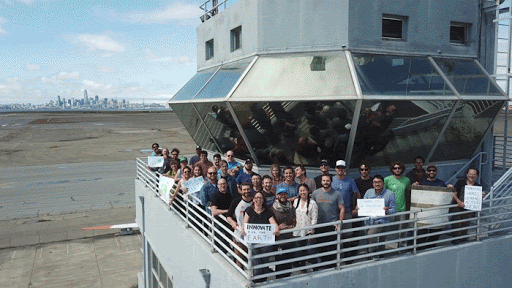Learn
Editor’s note: This blog was originally published on the Makani team blog by the Makani team on September 20, 2019. In 2020 Makani’s 13-year journey came to an end. You can explore Makani’s 13 years of technical development and insights in The Energy Kite Collection. Thank you to everyone who supported the Makani team on their journey.
This week, people around the globe are supporting youth as they call for increased action to combat climate change. For many of us on the Makani team, developing a new technology that works to advance global adoption of renewable energy is an objective that is not just our job, it’s a personal mission. As individuals, we’re engaging in climate action in the ways that resonate for each of us — some folks are participating in organized marches and rallies, while others are buckling down and working harder to make energy kites a reality. For all of us at Makani, this is a time for action.

The Makani team shows their support for innovative climate solutions from our headquarters in Alameda, California, across the bay from San Francisco.
We come to work each day to make progress towards the collective goal of developing a new way to generate clean power by creating kites that harness energy from the wind. Makani is made up of individuals with a breadth of unique experience as engineers, physicists, aerodynamicists, kiteboarders, artists, sailors, pilots, and tinkerers who have worked extensively in aerospace, renewables, and other emerging technologies. What unifies us is the drive to use our diverse backgrounds to bring an entirely new wind energy technology to life that will expand access to renewable energy around the globe.
For many on our team, creating energy kites is the sweet spot where individual technical expertise intersects with our collective ambition to make the world a better place. For controls engineer Michael Abraham, writing controls laws that enable our kite to fly autonomously means he can apply his skills as an Aerospace Engineer to support the global transition to clean energy. Michael relates, “I chose Aerospace Engineering because I wanted to solve interesting problems and because flying machines are amazing! Working at Makani allows me to use my aerospace skill set to make wind energy more available and more affordable.”
While earning degrees in Aero/Astro, Mechanical Engineering, and Ocean Engineering, Makani Chief Engineer, Paula Echeverri, was guided by the ambition to use her technical training to have a positive impact on the planet. “I want to work on solutions that make the world kinder and healthier,” Paula describes. “I want the subject of my work to allow me to contemplate and celebrate the beauty of the natural world. The other big aspect [of creating energy kites] is, it’s a technically challenging thing — so there’s a lot of things you can geek out about if you want to, and I find that really fun and interesting!”
The Makani team is creating energy kites to address the need for climate solutions.
To create new technology that is designed to combat a problem as big as climate change, Makani has forged a new path in wind power. We were founded on the premise that kites could harness energy from the wind in places that are not cost effective for existing technologies, and we are making steady progress towards commercialization.
From our scrappy beginnings experimenting with soft kiteboarding kites, through eight rigid kite designs, to our present 600kW prototype, Makani continues to routinely solve tough problems. We do that by creatively reducing complexity and by taking the right amount of risk to learn how we can keep improving our airborne wind energy system. Our recent offshore flight test demonstrated that our kites work in the floating offshore environment where they can have the greatest impact — eventually bringing affordable renewable power to hundreds of millions of people along the world’s coastlines.
To solve the climate crisis we need new technologies, but creating and maintaining hope and resilience as a community is equally important. Since Makani’s founding in 2006, the team has been able to solve the technical challenges we face not just through innovation and expertise, but through genuine care for the work we do and for each other. Taking on the climate crisis with kites is a bold idea, but we believe we’ve solved the technical miracles necessary to make energy kites a reality. What remains is to roll up our sleeves and work together with industry and community partners to get our kites out into the world where they can begin to affect meaningful change.